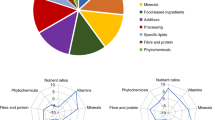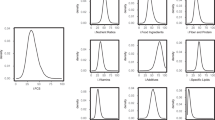Abstract
Background/Objectives:
To describe the strengths, limitations and requirements of using EPIC-Soft software (the software developed to conduct 24-h dietary recalls in the European Prospective Investigation into Cancer and Nutrition (EPIC) Study) in pan-European food consumption surveys, and to discuss potentials and barriers for a harmonized pan-European food consumption survey.
Subjects/Methods:
The paper is based on the experiences in the ‘European Food Consumption and Validation’ Project, which included updating six existing and preparing one new country-specific EPIC-Soft version, applying EPIC-Soft in validation and feasibility studies, and estimating the intake of nutrients and flavoring substances. The experiences were discussed in the September 2009 workshop ‘Pan-European Food Consumption Surveys—for Standardized and Comparable Transnational Data Collection’.
Results:
EPIC-Soft is suitable for detailed and standardized food consumption data collection in pan-European food consumption surveys. A thorough preparation of all aspects of the food consumption survey is important for the quality and efficiency during data collection and processing. The preparation and data-handling phase of working with EPIC-Soft is labor intensive and requires trained, motivated and qualified personnel.
Conclusions:
Given the suitability of EPIC-Soft as standardized dietary assessment tool in European dietary monitoring, the proposed strategy toward a pan-European food consumption survey is to prepare well, to allow flexibility in national extensions and to start with a limited number of countries that are interested.
This is a preview of subscription content, access via your institution
Access options
Subscribe to this journal
Receive 12 print issues and online access
$259.00 per year
only $21.58 per issue
Buy this article
- Purchase on Springer Link
- Instant access to full article PDF
Prices may be subject to local taxes which are calculated during checkout
Similar content being viewed by others
References
Al-Delaimy WK, Ferrari P, Slimani N, Pala V, Johansson I, Nilsson S et al. (2005a). Plasma carotenoids as biomarkers of intake of fruits and vegetables: individual-level correlations in the European Prospective Investigation into Cancer and Nutrition (EPIC). Eur J Clin Nutr 59, 1387–1396.
Al-Delaimy WK, Slimani N, Ferrari P, Key T, Spencer E, Johansson I et al. (2005b). Plasma carotenoids as biomarkers of intake of fruits and vegetables: ecological-level correlations in the European Prospective Investigation into Cancer and Nutrition (EPIC). Eur J Clin Nutr 59, 1397–1408.
Biro G, Hulshof KF, Ovesen L, Amorim Cruz JA (2002). Selection of methodology to assess food intake. Eur J Clin Nutr 56 (Suppl 2), S25–S32.
Brussaard JH, Lowik MR, Steingrimsdottir L, Moller A, Kearney J, De Henauw S et al. (2002). A European food consumption survey method--conclusions and recommendations. Eur J Clin Nutr 56 (Suppl 2), S89–S94.
Crispim SP, de Vries JH, Geelen A, Souverein OW, Hulshof PJ, Lafay L et al. (2011). Two non-consecutive 24 h recalls using EPIC-Soft software are sufficiently valid for comparing protein and potassium intake between five European centers—results from the European Food Consumption Validation (EFCOVAL) study. Br J Nutr 105, 447–458.
Crispim SP, Geelen A, Le Donne C, De Vries JH, Sette S, Raffo A et al. (2010). Dietary exposure to flavouring substances: from screening methods to detailed assessments using food consumption data collected with EPIC-Soft software. Food Addit Contam Part A Chem Anal Control Expo Risk Assess 27, 433–446.
Cuervo M, Brehme U, Egli IM, Elmadfa I, Gronowska-Senger A, Tetens I et al. (2007). Nutrition, dietetics and food sciences degrees across Europe. Ann Nutr Metab 51, 115–118.
de Boer EJ, Slimani N, van ’t Veer P, Boeing H, Feinberg M, Leclercq C et al. (2011). Rationale and methods of the European Food Consumption Validation (EFCOVAL) Project. Eur J Clin Nutr 65 (Suppl 1), S1–S4.
De Henauw S, Brants HA, Becker W, Kaic-Rak A, Ruprich J, Sekula W et al. (2002). Operationalization of food consumption surveys in Europe: recommendations from the European Food Consumption Survey Methods (EFCOSUM) Project. Eur J Clin Nutr 56 (Suppl 2), S75–S88.
Deharveng G, Charrondiere UR, Slimani N, Southgate DA, Riboli E (1999). Comparison of nutrients in the food composition tables available in the nine European countries participating in EPIC. European Prospective Investigation into Cancer and Nutrition. Eur J Clin Nutr 53, 60–79.
Dodd KW, Guenther PM, Freedman LS, Subar AF, Kipnis V, Midthune D et al. (2006). Statistical methods for estimating usual intake of nutrients and foods: a review of the theory. J Am Diet Assoc 106, 1640–1650.
EFSA (2008). The EFSA's 3rd Scientific Colloquium Report. European Food Consumption Database: Current and Medium to Long-Term Strategies. EFSA: Parma.
EFSA (2009). General principles for the collection of national food consumption data in the view of a pan-European dietary survey. EFSA J 7, 1–51.
Elmadfa I (2009). European Nutrition and Health Report 2009. Forum Nutr 62, 68–156.
Hendricks TC (1992). LanguaL. An automated method for describing, capturing and retrieving data about food. World Rev Nutr Diet 68, 94–103.
Huybrechts I, Casagrande C, Nicolas G, Geelen A, Crispim SP, De Keyzer W et al. (2011a). Inventory of experiences from national/regional monitoring surveys using EPIC-Soft. Eur J Clin Nutr 65 (Suppl 1), S16–S28.
Huybrechts I, Geelen A, de Vries JH, Casagrande C, Nicolas G, De Keyzer W et al. (2011b). Respondents’ evaluation of the 24-h dietary recall method (EPIC-Soft) in the EFCOVAL Project. Eur J Clin Nutr 65 (Suppl 1), S29–S37.
Kroger J, Ferrari P, Jenab M, Bamia C, Touvier M, Bueno-de-Mesquita HB et al. (2009). Specific food group combinations explaining the variation in intakes of nutrients and other important food components in the European Prospective Investigation into Cancer and Nutrition: an application of the reduced rank regression method. Eur J Clin Nutr 63 (Suppl 4), S263–S274.
Margetts BM (2009). Nutrient intake and patterns in the European Prospective Investigation into Cancer and Nutrition cohorts from 10 European countries. Eur J Clin Nutr 63 (Suppl 4), S1–S2.
Ngo J, Engelen A, Molag M, Roesle J, Garcia-Segovia P, Serra-Majem L (2009). A review of the use of information and communication technologies for dietary assessment. Br J Nutr 101 (Suppl 2), S102–S112.
Ocke MC, Larranaga N, Grioni S, van den Berg SW, Ferrari P, Salvini S et al. (2009). Energy intake and sources of energy intake in the European Prospective Investigation into Cancer and Nutrition. Eur J Clin Nutr 63 (Suppl 4), S3–S15.
Ocké MC, van Rossum CTM, Fransen HP, Buurma EM, de Boer EJ, Brants HAM et al. (2008). Dutch National Food Consumption Survey Young Children 2005/2006. RIVM: Bilthoven.
Parr CL, Hjartaker A, Scheel I, Lund E, Laake P, Veierod MB (2008). Comparing methods for handling missing values in food-frequency questionnaires and proposing k nearest neighbours imputation: effects on dietary intake in the Norwegian Women and Cancer study (NOWAC). Public Health Nutr 11, 361–370.
Saadatian-Elahi M, Slimani N, Chajès V, Jenab M, Goudable J, Biessy C et al. (2009). Plasma phospholipid fatty acid profiles and their association with food intakes: results from a cross-sectional study within the European Prospective Investigation into Cancer and Nutrition. Am J Clin Nutr 89, 331–346.
Schofield WN (1985). Predicting basal metabolic rate, new standards and review of previous work. Hum Nutr Clin Nutr 39 (Suppl 1), 5–41.
Slimani N, Bingham S, Runswick S, Ferrari P, Day NE, Welch AA et al. (2003). Group level validation of protein intakes estimated by 24-h diet recall and dietary questionnaires against 24-h urinary nitrogen in the European Prospective Investigation into Cancer and Nutrition (EPIC) calibration study. Cancer Epidemiol Biomarkers Prev 12, 784–795.
Slimani N, Casagrande C, Nicolas G, Freisling H, Huybrechts I, Ocké MC et al. (2011). The standardized computerized 24-h dietary recall method EPIC-Soft adapted for pan-European dietary monitoring. Eur J Clin Nutr 65 (Suppl 1), S5–S15.
Slimani N, Deharveng G, Charrondiere RU, van Kappel AL, Ocke MC, Welch A et al. (1999). Structure of the standardized computerized 24-h diet recall interview used as reference method in the 22 centers participating in the EPIC project. European Prospective Investigation into Cancer and Nutrition. Comput Methods Programs Biomed 58, 251–266.
Slimani N, Ferrari P, Ocke M, Welch A, Boeing H, Liere M et al. (2000). Standardization of the 24-h diet recall calibration method used in the European Prospective Investigation into Cancer and Nutrition (EPIC): general concepts and preliminary results. Eur J Clin Nutr 54, 900–917.
Souverein OW, Dekkers AL, Geelen A, Haubrock J, de Vries JH, Ocké MC et al. (2011). Comparing four methods to estimate usual intake distributions. Eur J Clin Nutr 65 (Suppl 1), S92–S101.
Stichting NEVO (2006). NEVO-tabel. Nederlands Voedingsstoffenbestand 2006. Voedingscentrum: Den Haag.
Subar AF, Thompson FE, Potischman N, Forsyth BH, Buday R, Richards D et al. (2007). Formative research of a quick list for an automated self-administered 24-h dietary recall. J Am Diet Assoc 107, 1002–1007.
Trolle E, Amiano P, Ege M, Bower E, Lioret S, Brants H et al. (2011a). Feasibility of repeated 24-h dietary recalls combined with a food-recording booklet, using EPIC-Soft, among preschoolers. Eur J Clin Nutr 65 (Suppl 1), S84–S86.
Trolle E, Amiano P, Ege M, Bower E, Lioret S, Brants H et al. (2011b). Evaluation of 2 × 24-h dietary recalls combined with a food-recording booklet, against a 7-day food-record method among schoolchildren. Eur J Clin Nutr 65 (Suppl 1), S77–S83.
Trubswasser U, Branca F (2009). Nutrition policy is taking shape in Europe. Public Health Nutr 12, 295–306.
Verkaik-Kloosterman J, van ‘t Veer P, Ocke MC (2009). Simulation model accurately estimates total dietary iodine intake. J Nutr 139, 1419–1425.
Acknowledgements
The provided information is largely based on the presentations and discussions during the EFCOVAL workshop as perceived by the authors. We thank Davide Arcella of EFSA and Trudy Wijnhoven at the WHO Regional Office for Europe in Copenhagen for presenting the plans and views of their organizations with regard to pan-European food consumption surveys. In addition, all participants, discussion leaders and discussion rapporteurs of the workshop are acknowledged for their valuable input. The Community, EFCOVAL Consortium, speakers and participants at the EFCOVAL workshop are not liable for any use that may be made of the information contained in the manuscript. The Community funding under the Sixth Framework Program for the EFCOVAL Project is acknowledged (FOOD-CT-2006-022895).
Author information
Authors and Affiliations
Consortia
Corresponding author
Ethics declarations
Competing interests
The authors declare no conflict of interest.
Rights and permissions
About this article
Cite this article
Ocké, M., Slimani, N., Brants, H. et al. Potential and requirements for a standardized pan-European food consumption survey using the EPIC-Soft software. Eur J Clin Nutr 65 (Suppl 1), S48–S57 (2011). https://doi.org/10.1038/ejcn.2011.87
Published:
Issue Date:
DOI: https://doi.org/10.1038/ejcn.2011.87
Keywords
This article is cited by
-
Importance of details in food descriptions in estimating population nutrient intake distributions
Nutrition Journal (2019)
-
Protocol of the Belgian food consumption survey 2014: objectives, design and methods
Archives of Public Health (2016)
-
Comparison of two food record-based dietary assessment methods for a pan-European food consumption survey among infants, toddlers, and children using data quality indicators
European Journal of Nutrition (2015)
-
Feasibility of dietary assessment methods, other tools and procedures for a pan-European food consumption survey among infants, toddlers and children
European Journal of Nutrition (2015)
-
Rationale and methods of the European Food Consumption Validation (EFCOVAL) Project
European Journal of Clinical Nutrition (2011)



